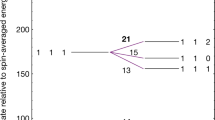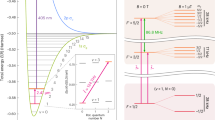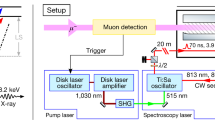Abstract
Molecular hydrogen ions are of high interest in fundamental physics and metrology. In particular, the long-range baryon–baryon interaction and the degrees of freedom of baryon rotational and vibrational motion are key features of molecular hydrogen ions. Here we present the measurement of a one-photon transition of HD+, a fourth overtone vibrational transition. Through a comparison of experimental and ab initio frequencies of this and previously measured transitions, we implement a test of the low-energy quantum physics of baryon interaction and motion. The results may also be interpreted as a test of Weinberg’s quantum mechanics extension. Furthermore, we compare the value of the fundamental constant combination μ/me = mpmd/(mp + md)me determined from our measurement with the value obtained from mass spectrometry experiments. This may also be regarded as a test of the quantum behaviour of baryons, revealing a moderate tension of 1.7 times the combined uncertainty. Combining our measurement result with some previous ones on HD+, we obtain a least-squares-adjusted value for μ/me as well as a bound for the force between the proton and deuteron in a scenario that is beyond the Standard Model of particle physics. No evidence of a deviation from conventional quantum physics is found.
This is a preview of subscription content, access via your institution
Access options
Access Nature and 54 other Nature Portfolio journals
Get Nature+, our best-value online-access subscription
$29.99 / 30 days
cancel any time
Subscribe to this journal
Receive 12 print issues and online access
$209.00 per year
only $17.42 per issue
Buy this article
- Purchase on Springer Link
- Instant access to full article PDF
Prices may be subject to local taxes which are calculated during checkout



Similar content being viewed by others
Data availability
Source data are available for this paper. All other data that support the plots within this paper and other findings of this study are available from the corresponding author upon reasonable request.
Code availability
No custom code or software was used for analysis and presentation of the data associated with this paper.
References
Caswell, W. & Lepage, G. Effective Lagrangians for bound state problems in QED, QCD, and other field theories. Phys. Lett. B 167, 437–442 (1986).
Korobov, V. I. & Karr, J.-P. Rovibrational spin-averaged transitions in the hydrogen molecular ions. Phys. Rev. A 104, 032806 (2021).
Alighanbari, S., Giri, G. S., Constantin, F. L., Korobov, V. I. & Schiller, S. Precise test of quantum electrodynamics and determination of fundamental constants with HD+ ions. Nature 581, 152–158 (2020).
Kortunov, I. V. et al. Proton–electron mass ratio by high-resolution optical spectroscopy of ion ensembles in the resolved-carrier regime. Nat. Phys. 17, 59–573 (2021).
Germann, M. et al. Three-body QED test and fifth-force constraint from vibrations and rotations of HD+. Phys. Rev. Research 3, L022028 (2021).
Weinberg, S. Lindblad decoherence in atomic clocks. Phys. Rev. A 94, 042117 (2016).
Blythe, P., Roth, B., Fröhlich, U., Wenz, H. & Schiller, S. Production of ultracold trapped molecular hydrogen ions. Phys. Rev. Lett. 95, 183002 (2005).
Hornekær, L., Kjærgaard, N., Thommesen, A. M. & Drewsen, M. Structural properties of two-component Coulomb crystals in linear Paul traps. Phys. Rev. Lett. 86, 1994–1997 (2001).
Kondov, S. S. et al. Molecular lattice clock with long vibrational coherence. Nat. Phys. 15, 1118–1122 (2019).
Amitay, Z., Zajfman, D. & Forck, P. Rotational and vibrational lifetime of isotopically asymmetrized homonuclear diatomic molecular ions. Phys. Rev. A 50, 2304–2308 (1994).
Karr, J.-P., Haidar, M., Hilico, L., Zhong, Z.-X. & Korobov, V. I. Higher-order corrections to spin-spin scalar interactions in HD+ and \({{{{\rm{H}}}}}_{2}^{+}\). Phys. Rev. A 102, 052827 (2020).
Korobov, V. I., Karr, J.-P., Haidar, M. & Zhong, Z.-X. Hyperfine structure in the \({{{{\rm{H}}}}}_{2}^{+}\) and HD+ molecular ions at order mα6. Phys. Rev. A 102, 022804 (2020).
Korobov, V. I. & Karr, J.-P. Spin–orbit interaction in the HD+ ion. Eur. Phys. J. D 76, 197 (2022).
Tiesinga, E., Mohr, P. J., Newell, D. B. & Taylor, B. N. CODATA recommended values of the fundamental physical constants: 2018. Rev. Mod. Phys. 93, 025010 (2021).
Haidar, M., Korobov, V. I., Hilico, L. & Karr, J.-P. Higher-order corrections to the spin-orbit and spin-spin tensor interactions in HD+. Phys. Rev. A 106, 042815 (2022).
Raizen, M. G., Gilbert, G. & Budker, D. Proposed test of quantum mechanics with three connected atomic clock transitions. Phys. Rev. A 106, 032209 (2022).
Karr, J.-P.\({{{{\rm{H}}}}}_{2}^{+}\) and HD+ : candidates for a molecular clock. J. Mol. Spectrosc. 300, 37–43 (2014).
Schiller, S., Bakalov, D. & Korobov, V. I. Simplest molecules as candidates for precise optical clocks. Phys. Rev. Lett. 113, 023004 (2014).
Bakalov, D. & Schiller, S. The electric quadrupole moment of molecular hydrogen ions and their potential for a molecular ion clock. Appl. Phys. B 114, 213–230 (2014).
Korobov, V. I., Danev, P., Bakalov, D. & Schiller, S. Laser-stimulated electric quadrupole transitions in the molecular hydrogen ion H\({}_{2}^{+}\). Phys. Rev. A 97, 032505 (2018).
Köhler, F. et al. The electron mass from g-factor measurements on hydrogen-like carbon 12C5+. J. Phys. B: At. Mol. Opt. Phys. 48, 144032 (2015).
Heiße, F. et al. High-precision mass spectrometer for light ions. Phys. Rev. A 100, 022518 (2019).
Rau, S. et al.Penning trap mass measurements of the deuteron and the HD+ molecular ion. Nature 585, 43–47 (2020).
Fink, D. J. & Myers, E. G.Deuteron-to-proton mass ratio from simultaneous measurement of the cyclotron frequencies of H\({}_{2}^{+}\) and D+. Phys. Rev. Lett. 127, 243001 (2021).
Salumbides, E., Ubachs, W. & Korobov, V. Bounds on fifth forces at the sub-Å length scale. J. Mol. Spectrosc. 300, 65–69 (2014).
Czachorowski, P., Puchalski, M., Komasa, J. & Pachucki, K. Nonadiabatic relativistic correction in H2, D2, and HD. Phys. Rev. A 98, 052506 (2018).
Morel, L., Yao, Z., Cladé, P. & Guellati-Khélifa, S. Determination of the fine-structure constant with an accuracy of 81 parts per trillion. Nature 588, 61–65 (2020).
Mount, B. J., Redshaw, M. & Myers, E. G. Atomic masses of 6Li, 23Na, 39,41K, 85,87Rb, and 133Cs. Phys. Rev. A 82, 042513 (2010).
Parker, R. H., Yu, C., Zhong, W., Estey, B. & Müller, H. Measurement of the fine-structure constant as a test of the Standard Model. Science 360, 191–195 (2018).
Sponar, S., Sedmik, R. I. P., Pitschmann, M., Abele, H. & Hasegawa, Y. Tests of fundamental quantum mechanics and dark interactions with low-energy neutrons. Nat. Rev. Phys. 3, 309–327 (2021).
Hori, M. et al. Buffer-gas cooling of antiprotonic helium to 1.5 to 1.7 K, and antiproton-to–electron mass ratio. Science 354, 610–614 (2016).
Borchert, M. J. et al. A 16-parts-per-trillion measurement of the antiproton-to-proton charge-mass ratio. Nature 601, 53–57 (2022).
Delaunay, C. et al. Self-consistent extraction of spectroscopic bounds on light new physics. Phys. Rev. Lett. 130, 121801 (2023).
Patra, S. et al. Proton-electron mass ratio from laser spectroscopy of HD+ at the part-per-trillion level. Science 369, 1238–1241 (2020).
Biesheuvel, J. et al. Probing QED and fundamental constants through laser spectroscopy of vibrational transitions in HD+. Nat. Commun. 7, 10385 (2016).
Koelemeij, J. C. J., Roth, B., Wicht, A., Ernsting, I. & Schiller, S. Vibrational spectroscopy of HD+ with 2-ppb accuracy. Phys. Rev. Lett. 98, 173002 (2007).
Bressel, U. et al. Manipulation of individual hyperfine states in cold trapped molecular ions and application to HD+ frequency metrology. Phys. Rev. Lett. 108, 183003 (2012).
Hori, M. et al. Two-photon laser spectroscopy of antiprotonic helium and the antiproton-to-electron mass ratio. Nature 475, 484–488 (2011).
Hollik, W. G., Linster, M. & Tabet, M. A study of New Physics searches with tritium and similar molecules. Eur. Phys. J. C 780, 661 (2020).
Alighanbari, S., Hansen, M. G., Korobov, V. I. & Schiller, S. Rotational spectroscopy of cold and trapped molecular ions in the Lamb–Dicke regime. Nat. Phys. 14, 555 (2018).
Schneider, T., Roth, B., Duncker, H., Ernsting, I. & Schiller, S. All-optical preparation of molecular ions in the rovibrational ground state. Nat. Phys. 6, 275–278 (2010).
Bakalov, D., Korobov, V. & Schiller, S. Magnetic field effects in the transitions of the HD+ molecular ion and precision spectroscopy. J. Phys. B: At. Mol. Opt. Phys. 44, 025003 (2011).
Schiller, S., Bakalov, D., Bekbaev, A. K. & Korobov, V. I. Static and dynamic polarizability and the Stark and blackbody-radiation frequency shifts of the molecular hydrogen ions \({{{{\rm{H}}}}}_{2}^{+}\), HD+, and \({{{{\rm{D}}}}}_{2}^{+}\). Phys. Rev. A 89, 052521 (2014).
Karr, J.-P., Hilico, L., Koelemeij, J. C. J. & Korobov, V. I. Hydrogen molecular ions for improved determination of fundamental constants. Phys. Rev. A 94, 050501 (2016).
Bakalov, D., Korobov, V. I. & Schiller, S. High-precision calculation of the hyperfine structure of the HD+ ion. Phys. Rev. Lett. 97, 243001 (2006).
Haidar, M. Hyperfine Structure in the Hydrogen Molecular Ions. PhD thesis, Univ. Sorbonne (2021).
Schiller, S. & Korobov, V. Test of time-dependence of the electron and nuclear masses with ultracold molecules. Phys. Rev. A 71, 032505 (2005).
Tiesinga, E., Mohr, P. J., Newell, D. B. & Taylor, B. N. Values of Fundamental Physical Constants https://physics.nist.gov/cuu/Constants/index.html (2019).
Korobov, V. I. & Zhong, Z.-X.Bethe logarithm for the \({{{{{\rm{H}}}}}_{2}}^{+}\) and HD+ molecular ions. Phys. Rev. A 86, 044501 (2012).
Kloor, H., Fischbach, E., Talmadge, C. & Greene, G. L. Limits on new forces coexisting with electromagnetism. Phys. Rev. D 49, 2098–2113 (1994).
Karshenboim, S. G. Precision physics of simple atoms and constraints on a light boson with ultraweak coupling. Phys. Rev. Lett. 104, 220406 (2010).
Acknowledgements
We are indebted to C.-J. Kwong and V. A. Vogt for contributing to the reference laser characterization, to E. Wiens for assistance with the frequency comb measurements and to M. G. Hansen for the maser characterization. The studies of additional rovibrational transitions were performed with crucial contributions by M. R. Schenkel. We thank V. I. Korobov for providing the BSM force sensitivities and the spin-averaged frequency value, as well as for helpful comments on the paper. We thank him and J.-Ph. Karr for the communication of results on the hyperfine structure before publication. O. Kullie provided some theoretical data. We are indebted to J. Leute and P. Uhrich for their gracious help with the maser stability characterization. We thank G. Morigi for a helpful discussion. We appreciate the important suggestions of the reviewers. This work has received funding from the European Research Council (ERC) under the European Union’s Horizon 2020 research and innovation programme (grant agreement no. 786306, ‘PREMOL’ (S.S.)) and from both Deutsche Forschungsgemeinschaft (DFG) and the state of Nordrhein-Westfalen via grants INST-208/737-1 FUGG (S.S.), INST-208/774-1 FUGG (S.S.) and INST-208/796-1 FUGG (S.S.).
Author information
Authors and Affiliations
Contributions
S.A. and I.V.K. contributed equally to this work. S.A., I.V.K. and G.S.G. performed the experiments and analysed the data. I.V.K. developed and characterized the laser system. S.A. maintained the apparatus. S.S. performed the analyses and wrote the paper. All authors contributed to review of the data and paper contents.
Corresponding author
Ethics declarations
Competing interests
The authors declare no competing interests.
Peer review
Peer review information
Nature Physics thanks Piotr Wcislo and the other, anonymous, reviewer(s) for their contribution to the peer review of this work.
Additional information
Publisher’s note Springer Nature remains neutral with regard to jurisdictional claims in published maps and institutional affiliations.
Extended data
Extended Data Fig. 1 Spectral characteristics of the 1.15 μm spectroscopy laser.
Left: (red) spectrum analyzer trace of the heterodyne beat of the reference laser 1 (1.06 μ m) and an independent sub-Hz-linewidth, low-drift frequency-stable laser of nearly same optical frequency (reference laser 2, 1.06 μ m); (inset, blue) the heterodyne beat between the spectroscopy laser and the spectrally closest mode of the frequency comb, while the spectroscopy laser is phase-locked to the comb and the comb is phase-locked to the reference laser 1. The solid lines are the lorentzian fits to the data points. The frequency offsets are arbitrary. The linewidths of the two beats and additional characterizations indicate that the spectroscopy laser has a linewidth of less than 10 Hz. Resolution bandwidth of the spectrum analyzer: 1 Hz, red trace - single sweep, sweep time 6 s, blue trace - average of 10 sweeps, time span of 1 min. The error bars are smaller than data markers. Right: (blue) Allan deviation of the frequency of the spectroscopy laser, measured relative to a hydrogen maser (maser 1) via the frequency comb; (green) Allan deviation of maser 1 relative to a second independent maser (maser 2). The shown values are the Allan deviation of the beat frequency divided by \(\sqrt{2}\); (red) Allan deviation of the beat of the reference laser 1 with reference laser 2. The error bars are estimated as 68% confidence intervals.
Extended Data Fig. 2 Sensitivity of transitions and their ratios to BSM forces.
The sensitivity is defined as X−1(dX/dβ), where \(X={f}_{{v}^{{\prime} }}\) or \({{{{\mathcal{R}}}}}_{a,b}\), and is computed as described in Methods, Sec. 1.5. β has units of energy. (a): case of a BSM force between proton and deuteron, proportional to βpd. (b): case of a BSM force between electron and proton, proportional to βep. Full lines denote positive values, dashed lines negative values. The brown, cyan, and gray lines in panel (b) are very close.
Extended Data Fig. 3 Comparison of results on the fundamental mass ratio μ/me.
μ = mpmd/(mp + md) is the reduced proton-deuteron mass. “Penning traps” (dark cyan): computed using the CODATA 2018 value for me/u (that relies mostly on ref. 21), md/u23, md/mp24. CODATA 2018 (black): μ/me computed using only the CODATA values for me/u, mp/u, md/u. The vertical line corresponds to zero of x axis. Note that the value and uncertainty of the “CODATA 2018” entry is significantly correlated with the “Penning traps” entry. LSA-1 is based on f1 (cyan) and f5 (brown); LSA-1b is based on f0 (green), f1 (cyan) and f5 (brown). LSA-1b and LSA-3 (ED Table 5) are nearly identical. As can be seen, the results of the least-squares adjustments deviate from the respective weighted means of the included frequencies. This is due to the assumption of near-perfect correlation rQED of the theoretical uncertainties. The error bars represent standard uncertainty.
Extended Data Fig. 4 Hyperfine structure energy levels of HD+ in the two relevant rovibrational levels.
Shown are the values \({E}_{{{{\rm{spin}}}},p}^{({{{\rm{theor}}}})}/h\) for the ground vibrational level (v = 0, N = 0) (left) and \({E}_{{{{\rm{spin}}}},q}^{({{{\rm{theor}}}})}/h\) for the excited vibrational level \(({v}^{{\prime} }=5,{N}^{{\prime} }=1)\) (right) of the \({}^{2}{\Sigma }_{g}^{+}\) ground electronic state. The vertical axis is broken for better visualization. The numbers next to the arrows indicate the line numbers i(p, q), where p (q) denotes the particular lower (upper) spin state. In this work, line 12 and line 21 were measured. G1 refers to the sum of electron and proton spin, G2 to the sum of G1 and deuteron spin, and F to the sum of G2 and rotational angular momentum N. The ground rovibrational level has zero rotational angular momentum, N = 0, giving rise to 4 spin states with total angular momentum F = 0, 1, 2. The upper rovibrational level \(({v}^{{\prime} }=5,\,{N}^{{\prime} }=1)\) has 10 spin states, having values \({F}^{{\prime} }=0,\,1,\,2,\,3\). For both studied lines 12 and 21, the lower and upper hyperfine states have the same particle spin coupling \({G}_{1}={G}_{1}^{{\prime} }\) and \({G}_{2}={G}_{2}^{{\prime} }\). The line 12 measured here is analogous to line 12 in ref. 3 and to line 12 in ref. 4. The line 21 is analogous to line 16 in ref. 3. Spin states with total angular momentum F are (2F + 1)-fold degenerate in zero magnetic field. We denote the lines and corresponding transition frequencies in zero external fields by fline i. i indicates the position in the list {fspin,i} of the spin frequency values of all spin components in ascending order.
Supplementary information
Supplementary Information
Supplementary Sections A and B, Fig. 1 and Table 1.
Source data
Source Data Fig. 2
Coordinates of each data point and their uncertainties.
Rights and permissions
Springer Nature or its licensor (e.g. a society or other partner) holds exclusive rights to this article under a publishing agreement with the author(s) or other rightsholder(s); author self-archiving of the accepted manuscript version of this article is solely governed by the terms of such publishing agreement and applicable law.
About this article
Cite this article
Alighanbari, S., Kortunov, I.V., Giri, G.S. et al. Test of charged baryon interaction with high-resolution vibrational spectroscopy of molecular hydrogen ions. Nat. Phys. 19, 1263–1269 (2023). https://doi.org/10.1038/s41567-023-02088-2
Received:
Accepted:
Published:
Issue Date:
DOI: https://doi.org/10.1038/s41567-023-02088-2



